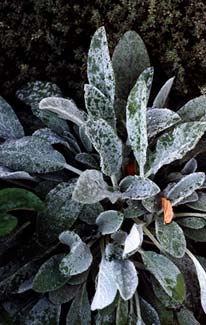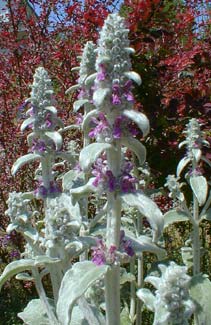
Lamb's Ear,
a low-maintance standard
Here at the top is a September (2002) photo of Lamb's Ears (Stachys lanata) on a dewy morning, dampness clinging to the furry leaves. It originated as a weed or wildflower with a natural range from Turkey southward through the Caucasus Mountains into Iran. It is sometimes called Woundwort, because the furry leaves were traditionally used as washrags to clean or as bandages to staunch wounds.
This gardening standard can be a little aggressive at spreading, for which reason a poorly blooming or non-blooming variety that won't self-seed has been developed, called "Silver Carpet Lambs Ears," but it has mixed reviews, some saying it goes too far the other direction & spreads way too slowly & is apt to rot from humidity or rainfall. There is also the non-blooming cultivar with double-sized "ears," called "Helen Von Stein" aka "Big Ears," which is said to be hardier than "Silver Carpet." I find "Big Ears" too floppy & unappealing.
 Regular ol' lambs ears blooms best for the bees & hummingbirds, is a very old gardening favorite for very good reasons, & is frequently available for free as a start from friends who have too much. Obviousy if you do want it to self-seed & spread about, the traditional variety is best.
Regular ol' lambs ears blooms best for the bees & hummingbirds, is a very old gardening favorite for very good reasons, & is frequently available for free as a start from friends who have too much. Obviousy if you do want it to self-seed & spread about, the traditional variety is best.The second photo is from June (2003), showing the flower stems at about four feet tall. Each fuzzy stem with fuzzy leaves with fuzzy flowerheads all of an even grey-green, except for the little flower petals which open purple. Very pretty! These do seem to draw energy away from the larger, groundcovering basal leaves, some of which turn brown or yellow from depletion. At some point the flower stalks need to be cut down to the base, & then the basal leaves will recover.
Lambs Ears are grown more for the downy-soft wooly-ear leaves than for flowers, but there's definitely something to be said for the spikes of purple-lilac blooms too. These have no particular odor except for the mild aroma of the leaves themselves. The spikes begin quite upright & rigid, but can become a bit sloppy-behaving & tippy. If you want the plant to remain compact & tidy, & don't want it to self-seed too broadly, just take the flower stalks out before they get tippy or go to seed.
As one of the truly easy plants to grow, it is ideal as a low groundcover in a street-side area, in a child's garden, a sunny rockgarden, poorly attended container, or for success in warmer climates with expensive water resources. Here on Puget Sound it is important to position it away from lawns or high-water-need plants, or it will suffer from overwatering.
In rockgardens it makes a nice "soft" break-up of sedums. Other low-water plants it lives well with include lavender, sage, catmint, artemisia, & thyme. We planted it specifically to mix with low-maintance herbs of that very sort, added in & around some of the shrubs we have on the street margin. The intention is to make that street area densely overgrown with perennials & shrubs, so that the ground disappears, yet without often having to go out to the road to water that area.